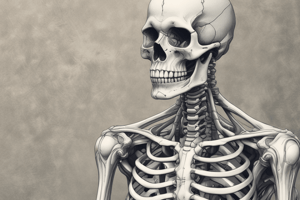Podcast
Questions and Answers
Describe the basic strokes used in swimming.
Describe the basic strokes used in swimming.
Front crawl, backstroke, breaststroke, and butterfly.
What is the purpose of floating in animals?
What is the purpose of floating in animals?
To conserve energy when food sources become scarce.
Explain the function of joints in the human body.
Explain the function of joints in the human body.
Joints facilitate movement by allowing bones to move against each other or by providing stability when movement is not necessary.
How does the nervous system contribute to movement?
How does the nervous system contribute to movement?
Describe the process of muscle contraction.
Describe the process of muscle contraction.
What are the three main gaits involved in terrestrial locomotion?
What are the three main gaits involved in terrestrial locomotion?
Describe the movement involved in creeping during terrestrial locomotion.
Describe the movement involved in creeping during terrestrial locomotion.
How do animals incorporate quadrupedal locomotion during crawling?
How do animals incorporate quadrupedal locomotion during crawling?
What is knuckle walking, and which animals practice it?
What is knuckle walking, and which animals practice it?
What are the three main modes of locomotion exhibited by humans?
What are the three main modes of locomotion exhibited by humans?
Flashcards are hidden until you start studying
Study Notes
Locomotion and Movement
Locomotion is the ability to move from one place to another in order to navigate and explore an environment. Humans have evolved various means of locomotion in order to adapt to different environments and tasks. Understanding these forms can help us appreciate the complex physiological processes involved in moving our bodies.
Types of Locomotion
Humans exhibit several modes of locomotion: terrestrial locomotion, such as walking and running; aquatic locomotion, like swimming; and flight, which we share with birds and bats. Each mode requires unique adaptations within the musculoskeletal system. For example, mammals' limbs support weight during flight but provide propulsion during swimming.
Terrestrial Locomotion
Terrestrial locomotion includes all movements that occur while standing still or moving around on land. This type involves three main gaits: creeping, crawling, and walking. Creeping describes the way babies move by pushing themselves forward with their hands and legs. Crawling involves belly sliding over flat surfaces and incorporates quadrupedal locomotion, where animals receive lift via a tail. Walking uses body weight to push off the ground and move forward. Higher primates also practice knuckle walking, where they walk on their knuckles while holding the forelimbs suspended above the ground.
Aquatic Locomotion
Aquatic locomotion is used underwater and encompasses swimming, diving, and floating. When humans swim, they utilize four basic strokes: front crawl, backstroke, breaststroke, and butterfly. These variations require specific adjustments in leg, arm, and body coordination depending on individual strengths and weaknesses. Divers take advantage of buoyancy while exploring depths found only in watery habitats. Floating allows animals to conserve energy when food sources become scarce.
Flight
Flight is unique to birds and bats, but humans have created artificial wings through devices like jetpacks and helicopters. Bird flight involves several steps: running along the ground with wings folded against the body; lifting into a glide by flapping wings upwards; transitioning from forward motion to wing-borne flight; transitioning back to ground locomotion after landing on perch; and gliding to another branch. Bats employ similar principles but also use echolocation for navigation and hunting.
Skeletal System
The skeletal system provides a protective framework for the body and plays a vital role in movement. It consists of bones, cartilages, ligaments, and joints. Each bony skeletal element acts as a lever, allowing muscles to pull on them to create movement.
Joints
Joints are the areas where bones meet. They facilitate movement by allowing bones to move against one another or by providing stability when movement is not necessary. There are three types of joints: fibrous joints (which do not allow movement), cartilaginous joints (which allow limited movement), and synovial joints (which enable a wide range of motion).
Nervous System
The nervous system coordinates movement by relaying signals from the brain to muscles and vice versa. This communication system consists of neurons, which are specialized cells that transmit electrical signals. Neuromuscular junctions serve as the interface between the nervous system and muscles, allowing the brain to control muscle contractions.
Muscle Contraction
Muscle contraction is the process by which muscles shorten or generate force, resulting in movement. Muscles are made up of long, thin cells called muscle fibers, and they contract when the molecule actin is pulled past myosin fibers. The act of contracting muscles consumes energy, so muscles can only maintain a contraction for a limited time before needing to relax and re-energize.
In summary, understanding locomotion and movement requires exploring various aspects of the human body, including types of locomotion, the skeletal system, joints, the nervous system, and muscle contraction. Each component plays a critical role in enabling us to navigate our environment and adapt to different situations.
Studying That Suits You
Use AI to generate personalized quizzes and flashcards to suit your learning preferences.




